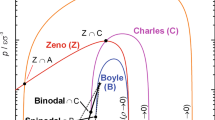Abstract
Viscosities at 10 and 25°C and dielectric constants at 10°C are reported for ethanol-water mixtures. Precise transference numbers for KBr at 10°C were determined by the moving-boundary method for five solvent mixtures containing up to 20 mole % ethanol. Conductance measurements for the alkali halides and tetraalkylammonium bromides were carried out across the complete range of solvent composition at 25°C, but for the water-rich region only at 10°C. The resulting limiting ionic Walden products confirmed the conclusions arrived at from earlier measurements. The maxima occurring in the water-rich region cannot be attributed solely to a structure-breaking effect owing to the ionic size dependence which is in the wrong direction. The tetraalkylammonium ions in these mixtures do not exhibit an enhanced hydrophobic effect, nor do they appear to enhance structure of any kind. Rather, the addition of alcohol to an aqueous Bu4N+ solution merely reduces the magnitude of the hydrophobic effect, as illustrated by a steadily increasing Walden product in the water-rich region. A decrease in temperature has no effect on the Walden product for the Bu4N+ ion but increases the magnitude of the maxima for the alkali-metal and halide ions. These maxima are attributed to sorting of the solvent components by the ionic charge, due to an acid-base type interaction, so that the proportion of water in the ionic cospheres is greater than in the bulk solvents. The sorting effect is shown to be temperature independent. The oxyanions are shown to exhibit a behavior in these mixtures that cannot be identified at this time.
Similar content being viewed by others
References
R. L. Kay and T. L. Broadwater,Electrochim. Acta 16, 667 (1971).
T. L. Broadwater and R. L. Kay,J. Phys. Chem. 74, 3802 (1970).
R. L. Kay, G. P. Cunningham, and D. F. Evans, inHydrogen-Bonded Solvent Systems, A. K. Covington and P. Jones, eds. (Taylor and Francis, London, 1968), p. 249.
F. Franks and D. J. G. Ives,Quart. Rev. (London) 20, 1 (1966).
Water, a Comprehensive Treatise, F. Franks, ed. (Plenum Press, New York, 1973):
Vol. 2, Chap. 5;
Vol. 2, Chap. 7;
Vol. 2, Chap. 8;
Vol. 2, Chap. 9;
Vol. 2, Chap. 10;
Vol. 3 Chap. 3;
Vol. 3, Chap. 4.
G. J. Janz and R. P. T. Tompkins,Nonaqueous Electrolytes Handbook (Academic Press, New York, 1972), Vol. 1.
R. Zwanzig,J. Chem. Phys. 52, 3625 (1970).
Cannon Instrument Co., State College, Pennsylvania.
G. A. Vidulich and R. L. Kay,Rev. Sci. Instrum. 37, 1662 (1966).
R. L. Kay and K. S. Pribadi,Rev. Sci. Instrum. 40, 726 (1969).
R. L. Kay, G. A. Vidulich, and A. Fratiello,Chem. Instrum. 1, 361 (1969).
D. F. Evans, C. Zawoyski, and R. L. Kay,J. Phys. Chem. 69, 3878 (1965).
R. L. Kay, B. J. Hales, and G. P. Cunningham,J. Phys. Chem. 71, 3925 (1967).
R. L. Kay, C. Zawoyski and D. F. Evans,J. Phys. Chem. 69, 4208 (1965).
A. Fratiello and R. L. Kay,J. Solution Chem. 3, 857 (1974).
International Critical Tables (McGraw-Hill Book Co., New York, 1929), Vol. V, p. 22.
T. L. Broadwater and R. L. Kay,J. Solution Chem. 4, 475 (1975).
J. Wyman, Jr.,J. Am. Chem. Soc. 53, 3292 (1931).
G. Akerlof,J. Am. Chem. Soc. 54, 4125 (1932).
J. R. Graham and A. R. Gordon,J. Am. Chem. Soc. 79, 2350 (1957).
R. L. Kay, Transference Number Measurements, inTechniques in Electrochemistry, A. Salkind and E. Yeager eds. (Wiley-Interscience, New York, 1973), Vol. II, p. 61.
R. L. Kay and J. L. Dye,Proc. Nat. Acad. Sci. 49, 5 (1963).
International Critical Tables (McGraw-Hill Book Co., 1928), Vol. III.
R. M. Fuoss and F. Accascina,Electrolyte Conductance (Interscience, New York, 1959).
R. L. Kay,J. Am. Chem. Soc. 82, 2099 (1960).
J. L. Hawes and R. L. Kay,J. Phys. Chem. 69, 2420 (1965).
J. R. Graham, G. S. Kell, and A. R. Gordon,J. Am. Chem. Soc. 79, 2352 (1957).
H. O. Spivey and T. Shedlovsky,J. Phys. Chem. 71, 2165 (1967).
D. F. Evans and P. Gardam,J. Phys. Chem. 72, 3281 (1968).
H. S. Frank,J. Chem. Phys. 23, 2023 (1955).
R. L. Kay, D. F. Evans, and M. A. Matesich, inSolute-Solvent Interactions J. Coetzee and C. D. Ritchie, eds. (Marcel Dekker, New York, 1976), Vol. 2.
Author information
Authors and Affiliations
Rights and permissions
About this article
Cite this article
Kay, R.L., Broadwater, T.L. Solvent structure in aqueous mixtures. III. Ionic conductances in ethanol-water mixtures at 10 and 25°C. J Solution Chem 5, 57–76 (1976). https://doi.org/10.1007/BF00647181
Received:
Issue Date:
DOI: https://doi.org/10.1007/BF00647181




